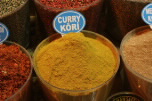FOR IMMEDIATE RELEASE
ACS News Service Weekly PressPac: November 04, 2009
ACS News Service Weekly PressPac: November 4, 2009
Contact
- Science Inquiries: Michael Woods, Editor, 202-872-6293
- General Inquiries: Michael Bernstein, 202-872-6042
![]()
New scientific discoveries are moving society toward the era of “personalized solar energy,” in which the focus of electricity production shifts from huge central generating stations to individuals in their own homes and communities. That's the topic of a report by an international expert on solar energy scheduled for the November 2 issue of ACS’ Inorganic Chemistry...
![]()

Scientists are reporting development of a nano-size capsule that boosts the body’s uptake of curcumin, an ingredient in yellow curry now being evaluated in clinical trials for treatment of several diseases. Their study is in ACS’ Journal of Agricultural and Food Chemistry, a bi-weekly publication. Koji Wada and colleagues note that curcumin is a potent antioxidant found in the spice...

Scientists in Canada are reporting the development of a fast, inexpensive “dipstick” test to identify small amounts of pesticides that may exist in foods and beverages. Their paper-strip test is more practical than conventional pesticide tests, producing results in minutes rather than hours by means of an easy-to-read color-change, they say. The study is in the November 1 issue of ACS’ Analytical Chemistry...
![]()

Scientists in Washington, D.C. are reporting laboratory evidence supporting the possibility that some of Earth’s oil and natural gas may have formed in a way much different than the traditional process described in science textbooks. Their study is scheduled for Nov./Dec. issue of ACS’ Energy & Fuels, a bi-monthly publication. Anurag Sharma and colleagues note that the traditional process…
![]()
Designers of anti-cancer drugs are aiming their arrows at mysterious chunks of the genetic material DNA that may play a key role in preventing the growth and spread of cancer cells, according to an article in the current issue of Chemical & Engineering News, ACS’ weekly newsmagazine. C&EN Deputy Assistant Managing Editor Stu Borman notes that the DNA structures, which scientists term “quadruplexes” because they have four-sided structures, are a genre of folded DNA...
![]()

- Press releases, briefings, and more from ACS’ 238th National Meeting
www.eurekalert.org/acsmeet.php
http://www.ustream.tv/channel/acslive - Must-reads from C&EN: Chemists feel the jobs pinch, but less than rest of economy
The job market for chemical scientists continues to take a beating like the rest of the economy. But as often the case, things are not quite as bleak for scientists. While the overall U.S. unemployment rate reached 9.8 percent by the end of September, the level for chemists hovered around 4 percent, according to the American Chemical Society. And there may be some light at the end of the tunnel: experts predict that more chemists will be needed for projects designed to help slow global warming and develop renewable energy. For more details, go to chem jobs. - Writing on Green Chemistry?
Here is a treasure trove of important scientific research articles published in 2008.
http://pubs.acs.org/stoken/presspac/presspac/full/10.1021/op900082k - ACS Pressroom Blog The ACS Office of Public Affairs (OPA) pressroom blog highlights research from ACS’ 34 peer-reviewed journals and National Meetings.
- Bytesize Science blog Educators and kids, put on your thinking caps: The American Chemical Society has a blog for Bytesize Science, a science podcast for kids of all ages.
- ACS satellite pressroom: Daily news blasts on Twitter
The satellite press room has become one of the most popular science news sites on Twitter. To get our news blasts and updates, create a free account at https://twitter.com/signup. Then visit http://twitter.com/ACSpressroom and click the ‘join’ button beneath the press room logo. - ACS Press Releases
Press releases on a variety of chemistry-related topics. - General Chemistry Glossary
- Chemical Abstracts Service (CAS)
Whether you want to learn more about caffeine, benzoyl peroxide (acne treatment), sodium chloride (table salt), or some other familiar chemical, CAS Common Chemistry can help. The new Web site provides non-chemists and others with useful information about everyday chemicals by searching either a chemical name or a corresponding CAS Registry Number. The site includes about 7,800 chemicals of general interest as well as all 118 elements from the Periodic Table, providing alternative names, molecular structures, a Wikipedia link, and other information. - Science Connections from CAS
CAS - Science Connections is a series of articles that showcases the value of CAS databases in light of important general-interest science and technology news. Topics range from fruit flies to Nobel Prize winners, with the CAS - Science Connections series pointing to CAS databases for a more complete understanding of the latest news.
- Bytesize Science
Bytesize Science is a science podcast for kids of all ages that entertains and educates, with new high-definition video podcasts and some episodes in Spanish. Subscribe to Bytesize Science using iTunes. No iTunes? No problem. Listen to the latest episodes of Bytesize Science in your web browser. - Global Challenges/Chemistry Solutions
This special series of ACS podcasts focuses on some of the 21st Century’s most daunting challenges, and how chemists and other scientists are finding solutions. Subscribe at iTunes or listen and access other resources at the ACS web site www.acs.org/GlobalChallenges. - Science Elements
Science Elements is a podcast of PressPac contents that makes cutting-edge scientific discoveries from ACS journals available to a broader public audience. Subscribe to Science Elements using iTunes. Listen to the latest episodes of Science Elements in your web browser. - SciFinder® Podcasts
Interested in healthful plant phytochemicals, nanotechnology, or green chemistry? Check out the SciFinder series of podcasts, which explore a vast array of current interest topics and new discoveries in the 21st century. The SciFinder podcasts are available in English, Chinese, Japanese, and Portuguese.
Note to Journalists and Other Viewers
This is the latest American Chemical Society (ACS) Office of Public Affairs Weekly PressPac with news from ACS’ 34 peer-reviewed journals and Chemical & Engineering News.
This information is intended for your personal use in news gathering and reporting and should not be distributed to others. Anyone using advance ACS Office of Public Affairs Weekly PressPac information for stocks or securities dealing may be guilty of insider trading under the federal Securities Exchange Act of 1934.
Please cite the individual journal, or the American Chemical Society, as the source of this information.
The American Chemical Society is a nonprofit organization chartered by the U.S. Congress. With more than 154,000 members, ACS is the world’s largest scientific society and a global leader in providing access to chemistry-related research through its multiple databases, peer-reviewed journals and scientific conferences. Its main offices are in Washington, D.C., and Columbus, Ohio.

